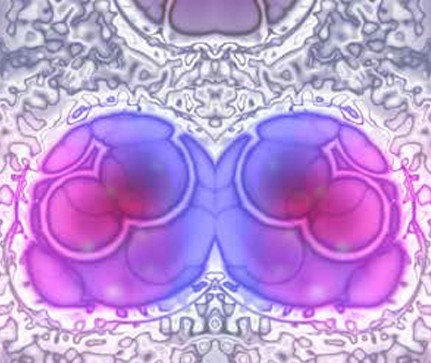Growing Cells on Mirrors Gives Scientists Better Insight

By Christina Phillis
Scientists have been studying cells for centuries, but have been missing out on an especially important view of cells: the interior. By growing cells on mirrors and imaging them using super-resolution microscopy, scientists have been able to solve this problem and see clearly inside. Using existing microscopes and techniques, one can only see the horizontal and vertical axes of a cell at a high resolution. The Z-axis, which is what scientists see when they look directly into the cell perpendicular to the glass, was blurry at best.
“Previously, the vision of biologists was blurred by the large axial and lateral resolution,” said Peng Xi, PhD, professor, Peking University. “This was like reading newspapers printed on transparent plastic; many layers were overlapped.”
MEANS Microscopy
The new technique, called mirror-enhanced axial-narrowing super-resolution (MEANS) microscopy, involves growing cells on mirrors instead of glass slides. A glass cover slide is then placed over the cells and the mirror is placed into a confocal or widefield microscope.
Using the properties of light, interference patterns are created as light waves pass through a cell on their way to the mirror and then back again after being reflected. “The two waves interacting with one another causes a region between the glass surfaces and the cell to be bright, and other parts to be dark,” said Philip Santangelo, associate professor, Georgia Tech College of Engineering and Emory University School of Medicine. “They cause light to be removed from some locations so you get darkness, and there is a bright spot in a specific region rather than being all bright.” The interference patterns helped to significantly improve resolution in the Z-axis, with stimulated emission depletion (STED) axial resolution increasing by a factor of six and lateral resolution by a factor of two.
One of the biggest advantages of this technique is that it doesn’t require increased laser power. This prevents damage to biological specimens and fluorescent dye, neither of which tolerates high laser power.
Challenges
Although the optical technique was not hard to develop, growing cells on mirrors presented a challenge at first. “Most people are not growing cells on mirrors, so it required some work to get the cell culture conditions correct,” said Santangelo. It required making sure the mirror coating didn’t affect cell growth and adapting current staining techniques to make the cells fluoresce. In the end, the scientists were able to develop a simple process for growing the cells on mirrors.
Changing How We See Cells
This new imaging technique has the potential to help researchers differentiate between structures that appear close together, but are actually far apart within cells.
“This simple technology is allowing us to see the details of cells that have never been seen before,” said Dayong Jin, PhD, paper coauthor, professor, University of Technology Sydney. “A single cell is about 10 micrometers; inside that is a nuclear core about 5 micrometers, and inside that are tiny holes, called the ‘nuclear pore complex,’ that as a gate regulates the messenger bio-molecules, but measure between one fiftieth and one twentieth of a micrometer. With this super-resolution microscopy we are able to see the details of those tiny holes.”
This is the first time scientists have been able to view the nuclear core complex as well as the human respiratory syncytial virus (hRSV). Viewing these microscopic structures within cells may allow scientists to learn new information about the behavior of cells. This could potentially help determine how diseases occur within cells.
Santangelo believes they have only scratched the surface with this technique, mentioning the ability to make the mirror’s surface moveable as a potential enhancement in the future.